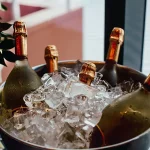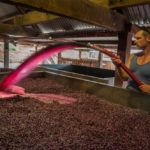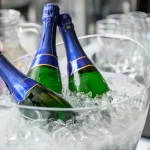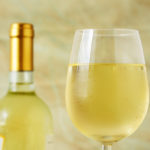The celebration has begun, you’ve popped the cork, topped everyone off, but there’s still some champagne left in the bottle.
Should you finish it right away? Or can you leave it for later? Will it still be good? Or will it go bad? How long can you leave the bottle open? Does it ever expire?
Don’t let your unanswered questions add agony to your sham-PAG-nee. Let’s break them all down, so you can pour, drink, and be merry no matter how much or how little you drink at a time.
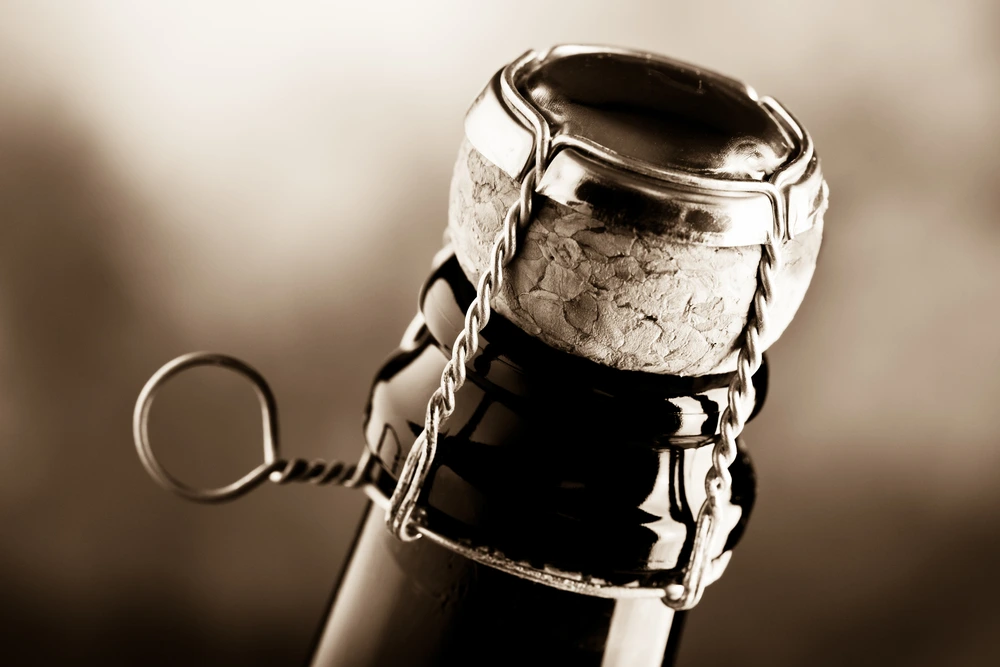
How Long Is an Open Bottle of Champagne Good For?
Experts agree that good quality sparkling wine can last at least 24 hours, but typically up to 5 days after it’s opened — if it’s sealed properly and stored in the fridge.
You can secure it using its original stopper (if it wasn’t damaged in the popping) or any number of cork, plastic, glass, or stainless steel varieties that clamp, twist, or snap to seal in the fizz.
Having a tight seal is key.
If there’s still some pressure from the bubbles, you don’t want the stopper to pop… you’ll end up with a mess and flat bubbly.
How to Keep an Open Bottle of Sparkling Wine or Champagne Fresh
Once you’ve popped the bottle, and you don’t fill up the flutes all at once, you can keep it fresh by putting it on ice.
Even if you don’t have a fancy ice bucket (and seriously, who really does?), just fill your sink, a large bowl, whatever you have with ice and a little salt, then bury the champagne in it for about 15-20 minutes.
How Can I Keep an Open Bottle of Champagne Fizzy?
This question is probably the most important, ‘cause let’s face it, what’s champagne without the… well… bubbly?
As we discovered before, keeping it cold and corked helps preserve the effervescence.
Or do a little MacGyvering and use plastic wrap and a rubber band over the top, and wrap the bottle in aluminum foil before you open it.
And then there’s this little controversial tidbit: put a spoon in it.
It may sound quirky (or would that be corky?), but some swear by putting a metal spoon with the handle facing down into the neck of the bottle (and back in the fridge, of course) and voilà!
The chilled metal supposedly creates a plug and prevents the air from bubbling out. It’s worth a try.
How Long Should I Keep an Opened Bottle of Sparkling Wine or Champagne in the Fridge?
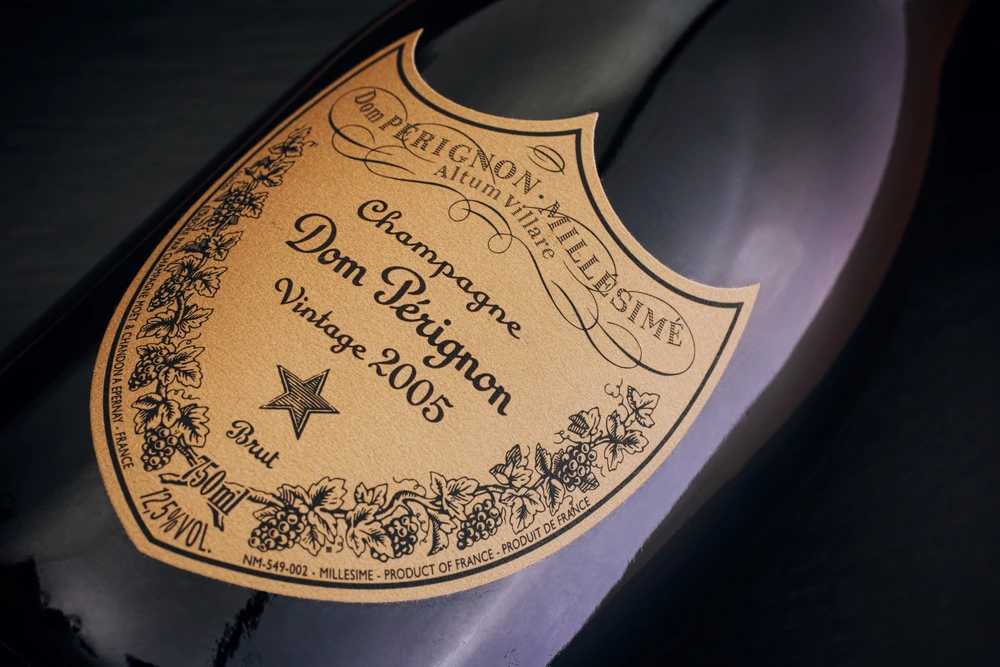
Every bottle of bubbly should be labeled “Best if used within 24 hours.”
But if that’s not possible, both vintage and non-vintage varieties of champagne will last about 3-5 days after popping the cork.
However, if you open Prosecco or Moscato, the Italians want you to really enjoy the here and now, because their sparkling grapes are best as soon as you unleash the lid.
Does Champagne and Sparkling Wine Freeze?
If you’re asking this question, you’re really taking the “put it on ice” thing pretty seriously.
However, in short, yes you can freeze it. But (and that’s a big BUT), it’s not the best idea.
Anytime you change the temperature of a delicately balanced, meticulously crafted mix of ingredients, you’re going to change the chemical composition (um, taste).
Not to mention, that champagne expands when it freezes so the bottle can break or the cork can pop out.
And you have to thaw it before drinking it… well… because if you don’t, you could have an explosive fountain of slushy grape juice on your hands and your cupboards and your floor.
Well, you get the picture.
But if you forgot that you left your bottle in a snowbank or thought it would be a good idea to put in the freezer, not to worry.
You can still salvage the carnage by adding it to Sangria or mixing it with a little orange juice for mimosas.
Disaster averted.
Will Old Champagne and Sparkling Wine Make Me Sick?
The good news: no!
Treat it like milk: smell it, taste it, look at it. Not sure it would get chunky like milk? (oops… forgot to warn you about that visual), but if it doesn’t look right, smells a little off, and doesn’t quite have the same flavor, it’s probably gone bad.
If you can stand the less than stellar sensations and don’t want to waste it, feel free. At least you know you won’t get sick.
You can also use old sour wine for other purposes.
What’s the Longest Time I Can Keep Champagne or Sparkling Wine Unopened?
The answer depends on what type of champagne we’re talking about: vintage or non-vintage.
Vintage is made from one year’s harvest; non-vintage from a few years harvest.
Vintage champagne is rarer (less than 10% is bottled each year) because it’s only produced in the most exceptional years, when the grapes are at their best.
So, let’s say you get a bottle of Bollinger or Veuve Clicquot for your wedding or a milestone birthday, you can hold on to it for a 10th (or 15th, sometimes even your 20th) anniversary celebratory toast.
As for non-vintage, think of them as the “early childhood” version of vintage. They only typically hang around about 4-5 years.
Related: Prosecco longevity.
Does Champagne Ever Expire?
Technically, the sparkling stuff doesn’t have a “use by” date, but champagne past its peak will lose some of its bubbly and have more of a sour taste.
But, hey, if you like it a little on the puckery side or some even say the loss of bubbles gives it a rich, buttery flavor, go for it.
Taste is in the mouth of the beholder.
Storage Tips: How to Store Sparkling Wine and Champagne at Home
Just like its cousin vino, sparkling wine and champagne should be stored in a consistently cool (65 degrees F/18 degrees C), dark place away from light and heat.
If you’re going to drink it within a month, stand it up.
If it’s going to be longer than that, lay it down. And keep it away from appliances that will vibrate the bottle.
Then, when you’re ready to uncork it, put it in the fridge a few hours beforehand (fridge good, freezer bad).
Related: Storage temperature for red and white wine.
So, Does Champagne Go Bad?
Unfortunately, yes, champagne can go bad… or at least, be in bad taste.
Some telltale signs are even before you pop the top.
Is the cork moldy, damaged, or dried out? Is the color more golden or yellow than you’d expect?
Even a perfectly pristine bottle can have passed its prime.
When you open it, is there a waft of a strange odor or loss of fruity aromas, no sign of fizz, and the taste is flat, even vinegary?
Well, yep, your bubbly has probably oxidized. And unfortunately, there’s no reversing it.
But how did it get that way?
First, consider what you started with.
Poorer quality ones will be murky or cloudy, give off an astringent or perfumey smell, and have a “loud” or abrasive flavor.
If you start with bad, well, it’s not going to miraculously get better over time… sorry.
Then there’s champagne and sparkling wines affinity to light and air.
Think of it like a sliced apple that’s been left out too long. It turns brown, starts to lose its smell and taste… due to oxidation. Champagne does the same thing.
And heat speeds up the process.
Sources like UV rays or that stylish rack by the refrigerator… well, you’re just cooking it with the appliance’s heat exhaust.
And then there’s time.
Even with the best intentions, the bubbles will slowly divide, reducing the carbonation, and eventually dissolving the liquid into acid.
As we discussed earlier, constant, cool temperatures and darkness will help preserve your sparkling drink longer.
A leading producer in the Champagne region of France even suggests that size matters… of the bottle, that is.
The larger the decanter, the more surface area there is, and the harder it is for temperature, UV, vibrations, or other external factors to affect it.
Sounds reasonable. But that, too, has its drawbacks… in price, quantity, and effectiveness to keep it fresh once it’s opened.
Now that you know the good, bad, and ugly of champagne and sparkling wine, pour your favorite and enjoy!
- Shrimp Cocktail (and More) Wine Pairing Guide - 09/06/2022
- What Wine Serving Sizes Look Like: Standard Size and More - 08/06/2022
- How Much Sugar is in Wine: Glass and Bottle Sugar Content - 08/06/2022

